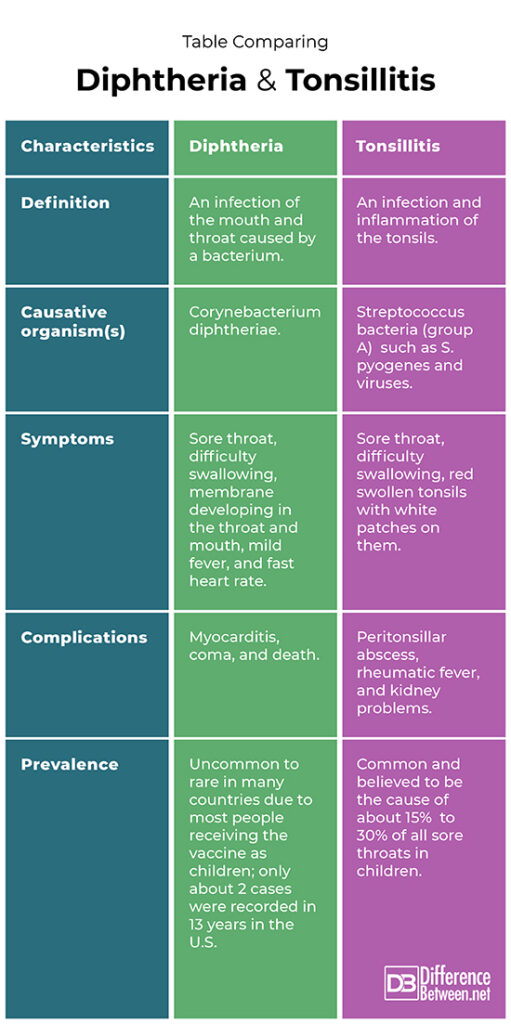Difference Between Diphtheria and Tonsillitis
Diphtheria is an infection of the nose and pharynx. Tonsillitis is an inflammation that affects the cells of the tonsils.

What is Diphtheria?
Definition:
This is when a bacterial organism infects and causes problems in the throat and nose and sometimes on the skin.
Causes and prevalence:
Corynebacterium diphtheriaebacterium is the most common cause of the illness. The danger is the toxin that the bacterium produces. Diphtheria is not a common illness in most parts of the world.
Symptoms:
There is some variation in signs depending on what part of the body is infected. If the diphtheria infection is in the throat and nose then symptoms include difficulty in swallowing, pain in the throat region, mild fever, and fast heart rate. A grey colored membrane often develops in the mouth and throat. This membrane bleeds if you try to remove it.
Complications:
Large amounts of toxin produced by the bacteria can result in myocarditis, coma, and death within a week.
Diagnosis:
The symptoms may suggest diphtheria, particularly the presence of the membrane. Gram staining of bacteria from a swab of the throat ca show the presence of the causative organism. Molecular biology techniques can also test for the presence of the bacterial DNA. The bacteria can also be grown in culture and identified in that way.
Treatment:
The antibiotics that can be used include erythromycin or penicillin. Diphtheria antitoxin can also be given to patients. The best is to avoid infection by getting vaccinated against diphtheria. It is a component of the DTaP vaccine.

What is Tonsillitis?
Definition:
This is when there is an inflammatory response affecting the tonsils.
Causes and prevalence:
The most common cause of inflamed tonsils is Streptococcus pyogenes, a group A type of Streptococcus. Viruses like that which causes the flu can sometimes cause tonsillitis. Tonsillitis is very common believed to cause about 15% to 30% of all sore throats in children. The infection is also more common in males than females.
Symptoms:
Symptoms of tonsillitis include painful swallowing, swollen tonsils, a sore throat, swollen lymph nodes in the neck. Tonsils often appear red and have white patches on them. There may also be bad breath and a sore neck.
Complications:
It can result in peritonsillar abscess if the infection on and around the tonsils worsens. Tonsillitis is caused by bacteria that can spread to the heart and joints causing rheumatic fever. The infection can spread to the kidneys causing inflammation.
Diagnosis:
A doctor can tentatively diagnose the condition by the symptoms and seeing the swollen and red tonsils. Confirmation can be obtained by taking a swab of the tonsils and culturing the bacteria in the lab.
Treatment:
Antibiotics such as amoxicillin or penicillin can be given to treat tonsillitis. If the problem persists a tonsillectomy may be done in which the tonsils are surgically removed.
Difference between Diphtheria and Tonsillitis?
Definition
Diphtheria is an infection of the mouth and throat caused by a bacterium. Tonsillitis is an infection and inflammation of the tonsils.
Causative organism(s)
Corynebacterium diphtheriaeis the bacterium that causes diphtheria. Streptococcus pyogenes and viruses cause tonsillitis.
Symptoms
The symptoms of diphtheria include sore throat, difficulty swallowing, membrane developing in the throat and mouth, mild fever, and fast heart rate. The symptoms of tonsillitis include sore throat, difficulty swallowing, and red swollen tonsils with white patches on them.
Complications
Diphtheria can lead to myocarditis, coma, and death. Tonsillitis can cause kidney inflammation, peritonsillar abscess, and rheumatic fever.
Prevalence
Diphtheria is very uncommon in countries with vaccination; only about 2 cases were recorded in 13 years in the U.S. Tonsillitis is very common and is likely the cause of 15% to 30% of all childhood sore throats.
Table comparing Diphtheria and Tonsillitis

Summary of Diphtheria Vs. Tonsillitis
- Diphtheria and tonsillitis are both conditions that can cause a sore throat.
- Tonsillitis is common and most often affects children.
- Diphtheria is rare in most countries because of immunization programs.
FAQ
Is tonsillitis and diphtheria the same?
Tonsillitis and diphtheria are different illnesses caused by pathogens that infect people.
What is the difference between diphtheria and strep throat?
Diphtheria is caused by a different bacterium and not by the Streptococcus which causes strep throat. A membrane also develops in diphtheria which is not the case in strep throat.
What’s the difference between a throat infection and tonsillitis?
In the case of tonsillitis, the tonsils are badly inflamed while a throat infection has less to no involvement of the tonsils. A throat infection is more a problem in the pharynx (throat region).
What’s the difference between tonsillitis and flu?
Tonsillitis is specifically an inflammatory response of the tonsils while the flu is a viral infection that affects many parts of the body.
What is the other name for diphtheria?
Diphtheria has had many other names including throat distemper, malignant croup, and Boulogne sore throat.
What bacteria causes tonsillitis?
Group A Streptococcus such as S. pyogenes commonly cause tonsil inflammation.
What kills tonsillitis fast?
Antibiotics kill the bacteria that cause tonsillitis.
What gets rid of tonsillitis quickly?
Surgical removal of the tonsils is often the fastest way to stop the problem.
Which antibiotics treat tonsillitis?
Amoxicillin and penicillin are used to treat tonsillitis.
- Difference Between Rumination and Regurgitation - June 13, 2024
- Difference Between Pyelectasis and Hydronephrosis - June 4, 2024
- Difference Between Cellulitis and Erysipelas - June 1, 2024
Search DifferenceBetween.net :
Leave a Response
References :
[0]Burton, Martin J., et al. "Tonsillectomy or adenotonsillectomy versus non‐surgical treatment for chronic/recurrent acute tonsillitis." Cochrane Database of Systematic Reviews 11 (2014).
[1]Bush, Larry M. and Maria T. Vasquez-Pertejo. “Diphtheria.” Merckmanuals. Merck & Co., 2022, https://www.msdmanuals.com/professional/infectious-diseases/gram-positive-bacilli/diphtheria
[2]Cheng, Alan G. “Tonsillopharyngitis (Tonsillitis; Pharyngitis)”. Merckmanuals. Merck & Co., 2022, https://www.msdmanuals.com/professional/ear,-nose,-and-throat-disorders/oral-and-pharyngeal-disorders/tonsillopharyngitis
